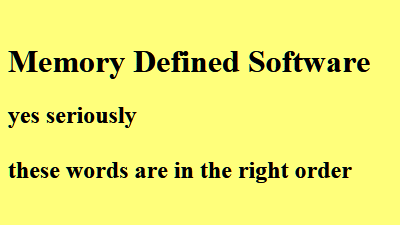Ratio of pricing - for enterprise FC SAN rackmount
RAM SSDs to SLC flash SSDs
update by Zsolt Kerekes,
editor - StorageSearch.com
source
- news stories and
interviews on StorageSearch.com
As you can see above in the
period 2007 to 2012 the price ratio of enterprise RAM SSDs compared to flash
SSDs for the same capacity declined from 45 to 1 down to 3 to 1 but that wasn't
enough to prevent the almost total disappearance of the
RAM SSD array market
due to electrical power, slot space and TCO considerations.
See
also:- RAM SSDs
versus flash SSDs? (technical comparisons) |
RAM SSDs
DIMM wars
SSD market analysts
SSD Jargon Explained
RAM Cache Ratios in
flash SSDs
Choosing
the Wrong SSD Supplier
RAM v Flash SSDs -
which is Best?
flash wars in the
enterprise SSD market
Clarifying SSD Pricing -
where does all the money go?
Exiting the
Astrological Age of Enterprise SSD Pricing
where are we
heading with memory intensive systems and software?
latency loving
reasons for fading out DRAM in the virtual memory slider mix |
 |
| ..... |
|
|
(published here August 2007)
It
does us a disservice to compare SSDs made with DRAM and NAND in today's light
and to assume that this is the way things will always be.
The greatest cost component of any SSD is its memory. Flash SSDs use
NAND, and RAM SSDs use DRAM.
NAND has been on a steeper price decline than DRAM for its entire
existence. The price of a gigabyte of DRAM declines (on average) 32% per year.
There are indications that this decline may slow. Meanwhile, NAND's price per
gigabyte declines faster, at an average of 50% per year. While NAND used to be
more costly than DRAM, in 2004 it crossed below DRAM.
Today a gigabyte of NAND costs less than 1/3rd as much as a gigabyte
of DRAM and the gap between the two is growing.
|
 |
Large system makers, those most
likely to use RAM SSDs, want to balance resources in their systems to get the
greatest performance per dollar, and they are very likely to use three forms of
mass storage in their systems: RAM, flash, and conventional HDD. Today, with
the 3:1 price difference between NAND and DRAM it makes sense to use a certain
amount of both technologies, but those amounts greatly depend upon the system's
task.
By the end of 2012, when a gigabyte of NAND costs 1/19th as
much as a gigabyte of DRAM, the optimum balance of flash/RAM will be very
different.
System analysts and IT managers need to understand how their
systems use disk storage in order to optimize their balance of flash to RAM.
These users should perform their benchmarks in such a way that they can ride
the downward trends in both RAM and flash pricing to get the highest performance
for the lowest cost, taking advantage of the growing price delta between the two
technologies. |
 |
see also:-
SSD news
the Fastest SSDs
the Top 10 SSD OEMs
RAM versus Flash SSDs
- which is Best?
SSD Myths and
Legends - "write endurance"
Are MLC SSDs Safe
in Enterprise Server Apps?
90% of
the enterprise SSD companies which you know have no good reasons to survive |
| |
|
|
| ... |
 |
| ... |
| SSD Pricing -
where does all the money go? |
| SSDs are among the most
expensive computer hardware products you will ever buy and comprehending the
factors which determine SSD costs is often a confusing and irritating
process... |
 |
...which is not made any
easier when market prices for apparently identical capacity SSDs have varied
more than 100x to 1!
Why is that? ...read the article to
find out | | | |
| ... |
| placing 3D XPoint claims in
context |
Editor:- June 23, 2016 - If you've been trying to
renconcile Intel
/ Micron
competitive claims about
3D
XPoint compared to flash and DRAM - it has been problematic due to absence
of adequate hard data.
A new video -
3D XPoint, reality,
opportunity, competition - by Sang Yung Lee,
President & CEO - BeSang -
places the known features of 3D XPoint into context, and looks at the
limitations, manufacturing costs and best likely application roles for this new
technology.
If you're interested in analyzing the impact of
DIMM wars
in your future plans - then the 12 minutes you spend listening to the narrative
in this video will remove any mysteries of how the IM technologies could fit
into the pattern of adoption and just as important - you'll see where 3D XPoint
is unlikely to be the best fit technology too. ...watch the video | | |
| ... |
|
|
| ... |
| the Problem with
Write IOPS in flash SSDs |
the "play it again Sam"
syndrome
Flash SSD "random write IOPS" are now similar
to "read IOPS" in many of the
fastest SSDs.
So
why are they such a poor predictor of application performance?
And
why are users still buying
RAM SSDs which cost an
order of magnitude more than SLC? (let alone
MLC) - even
when the IOPS specs look similar. |
 |
This article tells you
why the specs got faster - but the applications didn't. And why competing SSDs
with apparently identical benchmark results can perform completely
differently. ...read
the article | | | |
| ... |
 | |